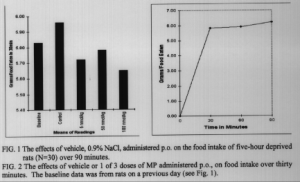Cory A. Talbot and Dr. Gregory N. Ervin, Psychology
Cholecystokinin (CCK) is a gut hormone released following the ingestion of a meal. It was first shown in 1973 by Gibbs et al. that administration of exogenous CCK-8 (CCK-8 is the smallest part of the CCK molecule that possesses its biological activity) before a meal leads to a decrease in food intake and the onset of satiety-like behaviors in rats.1 Extensive evidence now exists demonstrating that exogenous CCK-8 can produce a selective decrease in food intakes in humans, as well. By using CCK receptor antagonists to block endogenous CCK or trypsin inhibitors to elevate released endogenous CCK, some evidence is consistent with the possibility that endogenous CCK induces satiety and reduces food intake both in experimental animals and in humans.2,3
In this experiment we studied the effects of oral administration (peros, or p.o.) of pancreatic secretary trypsin inhibitor-I, or “monitor peptide” (MP) on feeding behavior in rats, testing the possible involvement of endogenous CCK-8 in mediating these effects. Trypsin and chymotrypsin in the intestinal lumen hydrolyze peptides such as MP. In theory, in the postprandial phase, trypsin and chymotrypsin will break down food, rather than hydrolyze MP, allowing MP to indirectly release more pancreatic enzymes. This effect of MP on the pancreas is thought to be mediated by the release of CCK-8 from endocrine cells in the duodenum. We predicted a reduction in food intake for the rats who received MP. However, in our experiment we found no such effect.
Before the experiment, the rats were minimally deprived of food daily. After their feeding stabilized we obtained baseline readings by giving all thirty of the rats a p.o. 0.9% NaCl solution injection (Fig. 1). The reason we did this was two-fold. First, it allowed us to more easily see the effect of the peptide on the rats since we could compare them to this previous reading. Also, the rats became accustomed to the injections and so their feeding was minimally affected by the interruptions of the handling and injections. The rats were also injected with exogenous CCK in order to test their sensitivity to the peptide. They proved to be very responsive.
During the course of the experiment, the rats were deprived of food overnight for five hours, and then they received 1 mL/kg p.o. injections. The control group of ten rats were injected with a 0.9% NaCl solution and the experimental groups (ten rats each) were injected with 5, 50, or 100 nmol/kg. of MP. Although the experimental groups did eat slightly less than the control groups, there was no statistical difference between the food intake of the experimental groups, the control groups, and the baseline readings (Fig. 2).
The results of this experiment opened up several possibilities. The first possibility was that perhaps MP, by itself, is not enough to produce satiety. Something else may be required to release a sufficient amount of endogenous CCK to produce satiety. Secondly, the formulation of the peptide we have been working with has not been made public to this point. Due to this fact, we had to order the peptide from another university. Following the experiment, we sent the remainder of the peptide back to our colleague, Dr. Green, at Texas University in order to ascertain whether or not the peptide was active for our experiment. He indicated that the peptide was inactive. Dr. Green and his colleagues are synthesizing more peptide, which should be available to us this fall. When we receive the peptide, we will again repeat the experiment at which time we hope to see the effects of monitor peptide in releasing endogenous CCK.
References
- Gibbs, J. R.C. Young, and G.P. Smith, G.P. (1973). “Cholecystokinin Decreases Food Intake in Rats.” J.Comp.Physiol.Psychol. 44:488-495. 1
- Ervin, G.N. (1994). “Cholecystokinin and Satiety: A Time Line. Cholecystokinin. Ann. NY Acad. Sci., ed. by Reeve, Jr., J.R., Eysselein, V., 2
- Solomon, T.E., and Go, V.L.W. The New York Academy of Sciences, New York, vol 713.
- Liddle, Rodger A. (1995). “Regulation of Cholecystokinin Secretion by Intraluminal Releasing Factors.” American Physiological Society G319.

